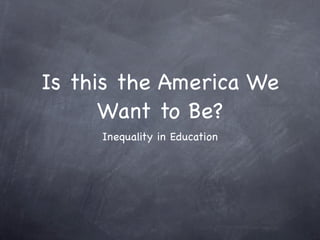
Bonner presentation
- 1. Is this the America We Want to Be? Inequality in Education
- 2. What Change? Children of color are not achieving as well as white students in the U.S. schools= big gap in admission rates, graduation rates, test scores, and achievement OVERALL More minority students are beginning to turn to the decision to attend college, but colleges turn them away. They want to succeed, but are not given the opportunity!-- >”Upward Mobility” Low-income, minority students are encouraged to attend a community college, but are not knowledgable of the fact that this is more expensive & less beneficial in the long run!-- >the students whom were spent less on since kindergarten somehow “belong” in the institutions that virtually guarantee we will continue to spend less on them=this is counterproductive and UN-AMERICAN
- 3. Why The Difference? Minority students, specifically African Americans, are too difficult to teach! These students deal with so many daily problems outside of school, so they have a difficulty in being educated! The students whose parents have a lower income it’s because they are lazy and don’t work as hard as others! Schools are forced to lower Pell Grant & amount of financial aid provided to college students who most need it!
- 4. Truth Is.... The fault of the low success rate of minorities is not of the daily issues they face everyday or their low-economic state. IT IS THE SCHOOLS RESPONSIBILITY! All of those Statements were FALSE-->The opposite is true!
- 5. The Ugly Side of These Institutions No Fair-share! There’s a small limit of useful teachers and resources!There are hardly any “good” teachers provided in classrooms of schools composed of these low-income, minority students. There is a decrease in the financial aid provided to students who REALLY NEED it. Students who don’t need it are receiving EXTRA funding!(EOF is experiencing this now!) There is poor preparation for students in this socio-economic group, so they are not given the same chance as the next student--Schools CHOOSE to do this, not forced! Activity
- 6. Where Is This Happening in The U.S.? Elementary Schools in low-income areas & which are highly populated of minority students Flagship Schools: in most cases, these are the 1st public universities to be established in their states. Flagship: term became associated with these schools after WWII formed the core public systems of higher education in their respective states. These schools became centers for research & graduate education, adding to size & scope example: RUTGERS UNIVERISITY
- 7. A Real Look at These Gaps Losing Our Children: http://www.edtrust.org/sites/edtrust.org/files/ publications/files/YesWeCan.pdf Rutgers Reports 2009: http://oirap.rutgers.edu/reports/ AandEreport.pdf
- 8. More Graphs: Flagship schools compared to others: http:// www.edtrust.org/sites/edtrust.org/files/ publications/files/Opportunity%20Adrift().pdf
- 9. “Uncommon education for the common man” The historic mission of Flagship universities Students who attend these schools represent the states that they are in less, but imitate the look of the students who attend elite private research universities. In 15 of the 22 states, the top-ranked private institution enrolls a higher proportion of minority students than the public flagship(This reverses when it comes to low-income students- 21% in Flagships vs. 15% in private universities.)
- 10. A Solution! COMMUNITY COLLEGES!!! Giving minority, low-income students a cheaper and more accessible opportunity to receive higher education was a GREAT idea!
- 11. Think About This: A 2009 Education Trust report, “Charting a Necessary Path,” examined success rates in 24 public higher education systems: 24% of underrepresented minorities who begin 2-year colleges complete anything within 4 yrs of entry-certificate, degree, or transfer 12 % who transfer to a 4-yr college, only 55% earn bachelor’s degrees within 6 years of transferring Which Means: only about 7% of minority students who begin a 2-yr colege earn a bachelor’s degree from any institution in these large systems within 10 yrs of starting Conclusion: This rate is far lower than among those who begin even in nonselective 4-yr colleges In 2006 Community College’ average in spending per degree $63,954- $14,073 more spent than compared to a public master’s college & $7,211 more than compared to average spending per degree at a public research college Part of the reasoning could be from the lower amount of funding they receive, but this is still an surprise!
- 12. We Need Change!! : The Real Solutions We have to lessen the gap! Community Colleges should be given more funding & provide good teachers and resources just as well as 4-yr. schools Flagship universities should provide financial aid to those who NEED it! There are high-achieving students from ALL backgrounds! (explain) We need more institutional leaders to make a choice of change, along with those who finance these institutions More finance=more resources, but we definitely need BETTER Educators!
- 13. “Lean on ME” “But we’re not aiming our students to go to college, we’re aiming higher than that-we’re aiming them at graduating college” Elmont Memorial Junior-Senior High School principal, Al Harper. “Because a child is poor doesn’t mean he can’t learn. Because a child lives in the projects doesn’t mean he can’t learn. If there are gaps, we as a society must fill those gaps”
Notes de l'éditeur
- \n
- \n
- \n
- \n
- \n
- \n
- \n
- \n
- \n
- \n
- \n
- \n
- \n